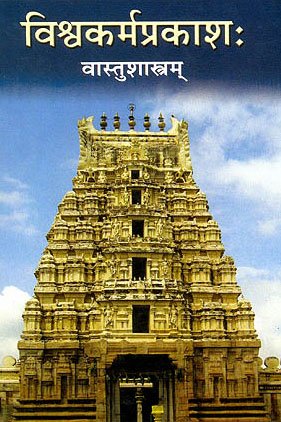Kirtita, Kīrtita: 6 definitions
Introduction:
Kirtita means something in Hinduism, Sanskrit, Jainism, Prakrit, the history of ancient India. If you want to know the exact meaning, history, etymology or English translation of this term then check out the descriptions on this page. Add your comment or reference to a book if you want to contribute to this summary article.
In Hinduism
Vastushastra (architecture)
Source: Brill: Śaivism and the Tantric Traditions (architecture)Kīrtita (कीर्तित) (Cf. Kīrtana) refers to “announcing (a creature’s name)”, according to the Devyāmata (in the section śalyoddhāra-paṭala or “excavation of extraneous substances”).—Accordingly, “[...] [The officiant] should carefully prognosticate the extraneous thing [underground] by observing [a creature] step over a cord, seeing [an auspicious or inauspicious thing], announcing a [creature’s] name (nāman-kīrtana), or hearing [an auspicious or inauspicious sound]. If [a creature] steps over [a cord] or is seen, or if one [hears] a cry of [a creature] or announce a [creature’s] name (nāman-kīrtita), then [the officiant] should prognosticate the extraneous thing [related to] that creature according to the stepping over and other [omens]. [...]”.

Vastushastra (वास्तुशास्त्र, vāstuśāstra) refers to the ancient Indian science (shastra) of architecture (vastu), dealing with topics such architecture, sculpture, town-building, fort building and various other constructions. Vastu also deals with the philosophy of the architectural relation with the cosmic universe.
Shaktism (Shakta philosophy)
Source: Google Books: ManthanabhairavatantramKīrtita (कीर्तित) refers to “being praised”, according to the Ṣaṭsāhasrasaṃhitā, an expansion of the Kubjikāmatatantra: the earliest popular and most authoritative Tantra of the Kubjikā cult.—Accordingly, “The face called ‘Unborn’ is on the plane of the End of the Twelve. It is the supreme, eternally active Brahman who is born from the abode of all the energies. It is Nirvāṇa, the qualitiless, tranquil and faultless Bliss of Stillness. Know that that is Śiva, the all-pervasive Lord who is the ground of the energy of his own will. Inexplicable and beyond the three (levels of) Speech, he (can only be) praised (kīrtita) indirectly”.

Shakta (शाक्त, śākta) or Shaktism (śāktism) represents a tradition of Hinduism where the Goddess (Devi) is revered and worshipped. Shakta literature includes a range of scriptures, including various Agamas and Tantras, although its roots may be traced back to the Vedas.
In Jainism
General definition (in Jainism)
Source: The University of Sydney: A study of the Twelve ReflectionsKīrtita (कीर्तित) refers to “that which is said”, according to the 11th century Jñānārṇava, a treatise on Jain Yoga in roughly 2200 Sanskrit verses composed by Śubhacandra.—Accordingly, “Good conduct is said (kīrtita) by one who is honourable [to be like a tree] whose roots are the five great vows, whose foliage is the [mendicant] rule of life which is faultless in a high degree, bent with the weight of the fruit of restraint [of body, mind and speech]”.

Jainism is an Indian religion of Dharma whose doctrine revolves around harmlessness (ahimsa) towards every living being. The two major branches (Digambara and Svetambara) of Jainism stimulate self-control (or, shramana, ‘self-reliance’) and spiritual development through a path of peace for the soul to progess to the ultimate goal.
India history and geography
Source: Cologne Digital Sanskrit Dictionaries: Indian Epigraphical GlossaryKīrtita.—(EI 24), ‘built’; cf. prakīrtita. Note: kīrtita is defined in the “Indian epigraphical glossary” as it can be found on ancient inscriptions commonly written in Sanskrit, Prakrit or Dravidian languages.

The history of India traces the identification of countries, villages, towns and other regions of India, as well as mythology, zoology, royal dynasties, rulers, tribes, local festivities and traditions and regional languages. Ancient India enjoyed religious freedom and encourages the path of Dharma, a concept common to Buddhism, Hinduism, and Jainism.
Languages of India and abroad
Sanskrit dictionary
Source: DDSA: The practical Sanskrit-English dictionaryKīrtita (कीर्तित).—p. p.
1) Said, asserted.
2) Mentioned, told.
3) Known; notorious.
4) Praised, celebrated.
Source: Cologne Digital Sanskrit Dictionaries: Monier-Williams Sanskrit-English Dictionary1) Kīrtita (कीर्तित):—[from kīrt] mfn. said, mentioned, asserted
2) [v.s. ...] celebrated known, notorious.
Sanskrit, also spelled संस्कृतम् (saṃskṛtam), is an ancient language of India commonly seen as the grandmother of the Indo-European language family (even English!). Closely allied with Prakrit and Pali, Sanskrit is more exhaustive in both grammar and terms and has the most extensive collection of literature in the world, greatly surpassing its sister-languages Greek and Latin.
See also (Relevant definitions)
Starts with: Kirtitaramgini, Kirtitarangini, Kirtitattva, Kirtitavya.
Ends with: Akirtita, Namakirtita, Parikirtita, Prakirtita, Samkirtita, Samparikirtita, Samprakirtita, Utkirtita.
Full-text (+8): Prakirtita, Kirtana, Parikirtita, Samkirtita, Muku, Utkirtita, Dharmavidhi, Arikeli, Shilajatu, Samuddesha, Bhukti, Kudara, Madhyadesha, Krit, Nama, Caritra, Pradesha, Unmada, Utthana, Kalyana.
Relevant text
Search found 21 books and stories containing Kirtita, Kīrtita; (plurals include: Kirtitas, Kīrtitas). You can also click to the full overview containing English textual excerpts. Below are direct links for the most relevant articles:
Garga Samhita (English) (by Danavir Goswami)
Verse 5.15.30 < [Chapter 15 - Seeing Sri Radha]
Verse 8.13.131 < [Chapter 13 - A Thousand Names of Lord Balarāma]
Bhakti-rasamrta-sindhu (by Śrīla Rūpa Gosvāmī)
Verse 4.7.13 < [Part 7 - Ghastliness (vībhatsa-rasa)]
Verse 3.3.91 < [Part 3 - Fraternal Devotion (sakhya-rasa)]
Kashyapa Shilpa-shastra (study) (by K. Vidyuta)
3. The Breadth, Length and Height of the Gopuras < [Chapter 5 - Gopura Lakṣaṇa]
Manusmriti with the Commentary of Medhatithi (by Ganganatha Jha)
Verse 10.131 < [Section XV - Summary]
Verse 1.42 < [Section XXIV - Creation of Insects and Reptiles and Immovable Things]
Verse 5.73 < [Section IX - Other forms of Impurity]
Mandukya Upanishad (Gaudapa Karika and Shankara Bhashya) (by Swami Nikhilananda)
Mandukya Karika, verse 4.96 < [Chapter IV - Alatashanti Prakarana (Quenching the firebrand)]
Mandukya Karika, verse 4.72 < [Chapter IV - Alatashanti Prakarana (Quenching the firebrand)]
The Tattvasangraha [with commentary] (by Ganganatha Jha)
Verse 3199-3201 < [Chapter 26 - Examination of the ‘Person of Super-normal Vision’]